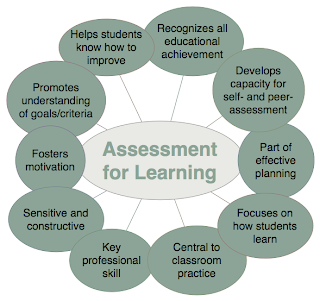Nowadays the role of the teacher and student in the classroom are changing. The teacher is no longer the only source of knowledge/content. However, he still plays a key role in guiding his students during the teaching-learning process, in the awareness of one’s own learning. And from that perspective arises the trinomial assessment-teaching-learning, because assessment thus becomes a crucial element that allows the success of the process itself.
We have to point out that there are two main types of:
In Primary MFL learning should be located within a formative assessment framework that focuses on establishing what the children can do and offers feedback as to how they can progress. Progression in learning is a major issue of quality and enduring primary MFL provision. If children are not given feedback or assessed on their performance, they will not progress. AFL should not be confused with assessment of learning, which is summative and is used to measure pupils’ achievements in the form of, for example, standarised tests.
Instruments for AFL
In the case of Primary’s pupils, traditional learning can be problematic: sometimes, an exam, or a “paper and pencil test” does not show what pupils really know and can do. Instead, it can be stressful and tiring for them, even more, an inappropriate assessment method could discourage pupils, losing their motivation and self-confidence. It is important that AEL for children is handled with care, to monitor it on a planned basis. Monitoring is a part of assessment and can be carried out in a variety of ways (preferably in combination with each other): observation, self-assessment, peer-assessment, portfolio, project work, rubric,…
Classroom observation could be tool to assess pupils’ performance, collecting in children’s work, observing displays and discussion with staff and children. As a foreign language teacher we should take into account the fact that primary languages learners need to learn how to use and structure language rather than learning isolated lists of individual words. Learners need to move from knowing vocabulary to using it productively and manipulating words as necessary.
Assessment for learning is a powerful way of raising pupils’ achievement. It is based on the principle that pupils will improve most if they understand the aim of their learning, where they are in relation to this aim and how they can achieve the aim. As teachers we need to consider that students must clearly identify the learning objectives, not just the content of what they will learn in each lesson. Thus, the teacher allows them to participate in the running of the class, students will feel closer to him/her, confident in their own possibilities and will gradually assume more control and responsibility for their learning.
To achieve an effective assessment, feedback is crucial. It needs to be given immediately so that children can self-assess and learn the value of errors in order to take responsibility for the learning process. A useful tool for self-assessment is the portfolio, because it provides an overview of children’s achievements. Younger pupils will find this harder at first, so we will have to take it slowly. On the other hand, students respond better to the activity when they decide on it, that is, when they make decisions and feel responsible for the activity. Activities can be discusses by the students. Furthermore, this will increase if students manage to see the activity as their own and not as an obligation.
It is very important to know students’ point of views about their work, activities, tasks,… In this way, they will drive their own self-assessment. They are assessed on what they have learned with the completion of an activity, and so the teacher will know if the proposed activity had worked or not.
Moreover, Peer-assessment improves pupils’ communication (between them and the teacher about their learning), their motivation to work harder; they more accept criticism from their classmates than from their teacher; they learn by taking the roles of teachers and examiners of others.
Another important aspect, it is that as teachers we should inspire learning through a passion for the subject, in that way we will achieve better results with pupils. Because students realize when the teacher is involved, and they act the same way, knowing that their efforts will be recognized.
The teacher should always be aware of students’ different learning styles. In fact, most individuals are most effective when they are taught and assessed in their personal learning style. From our experience, teachers often do not take that into account. Following the Gardner’s Theory of multiple intelligences students learn differently and that's what teachers should consider the early going. That means that all children could progress at their own pace (comparison among pupils are discouraged).
Schools’ assessment records should be manageable, otherwise they no longer serve their purpose. Records are interesting for a teacher as they tell us what we need to know to achieve an effective assessment.
Finally, we would like to say that we have to keep in mind that each student is different and depending on the subject or activity that is proposed, we must find the assessment that best suits our students.
( click concept map to enlarge) This concept map was constructed from the 10 principles of Assessment for Learning. They are researched based principles, from Assessment Reform Group, for assessing and guiding learners and classroom practices.


No hay comentarios:
Publicar un comentario